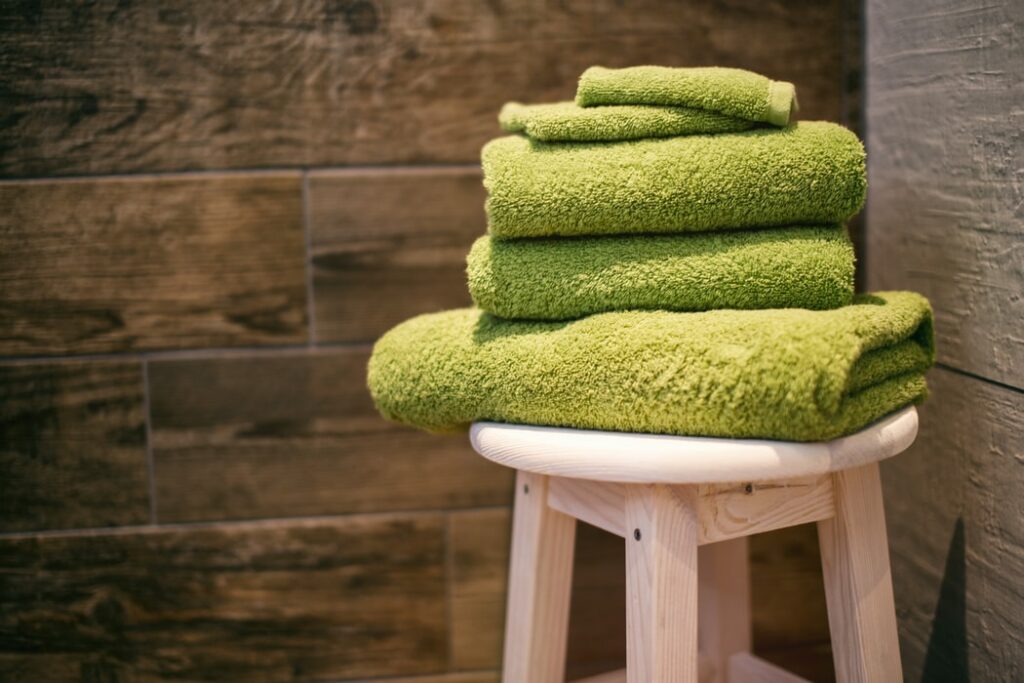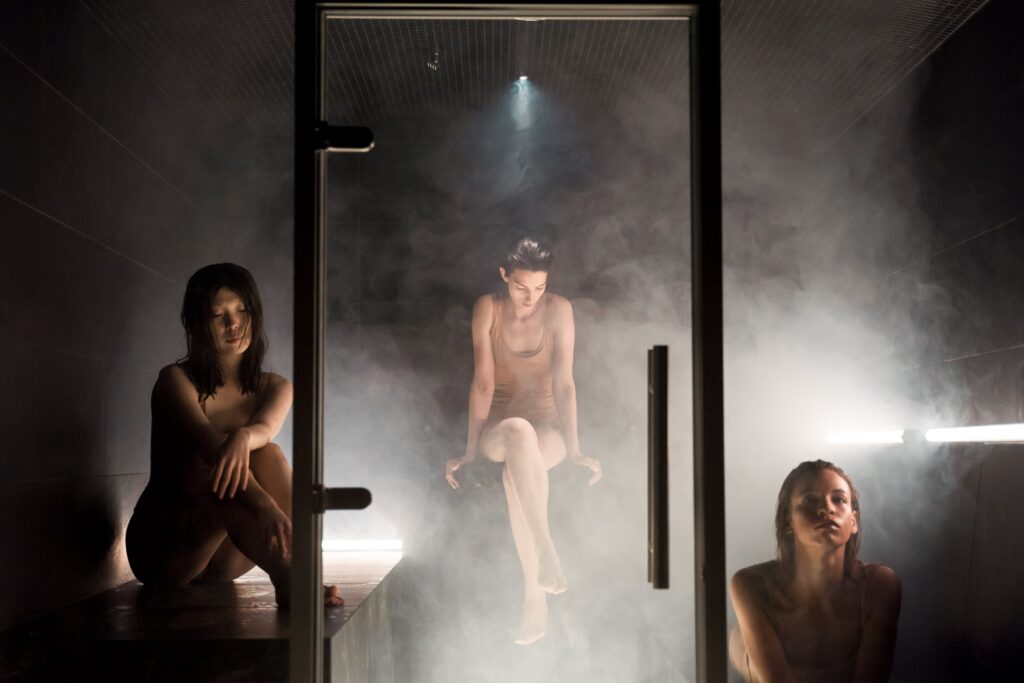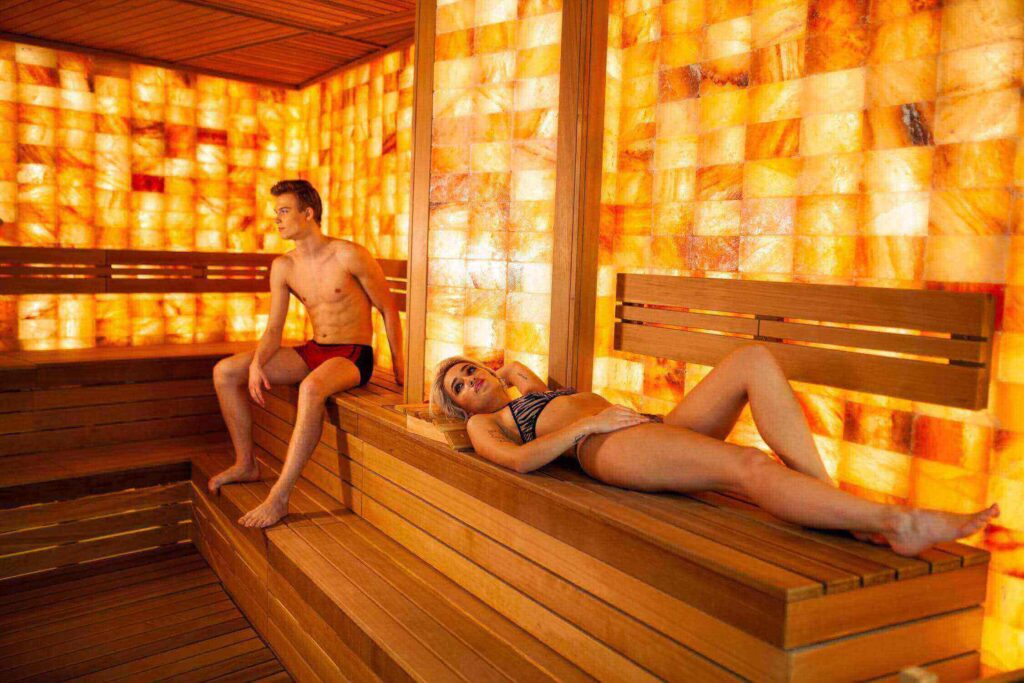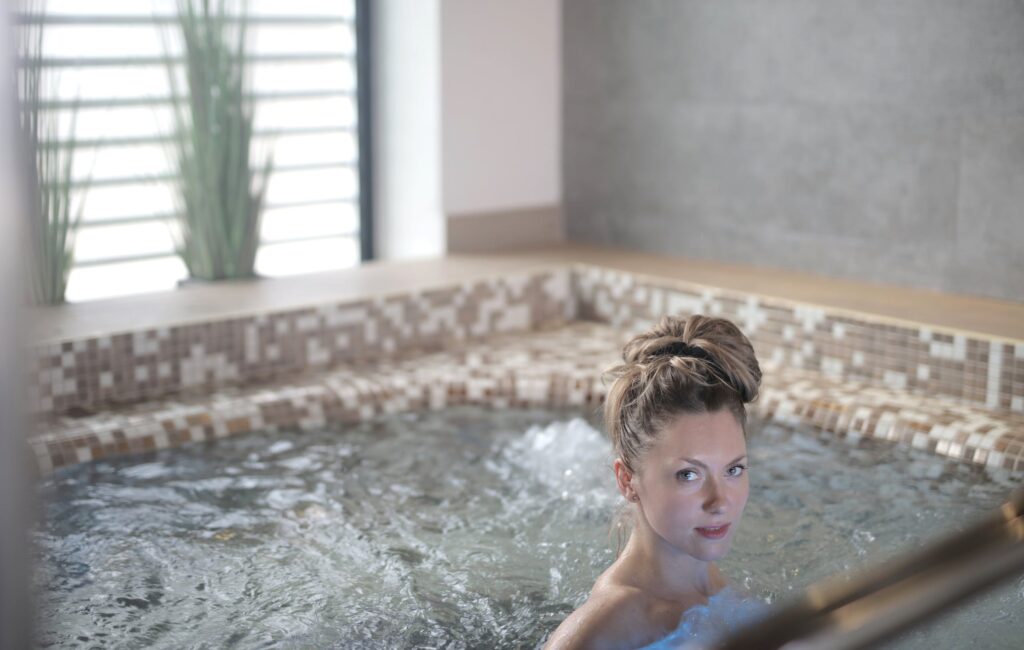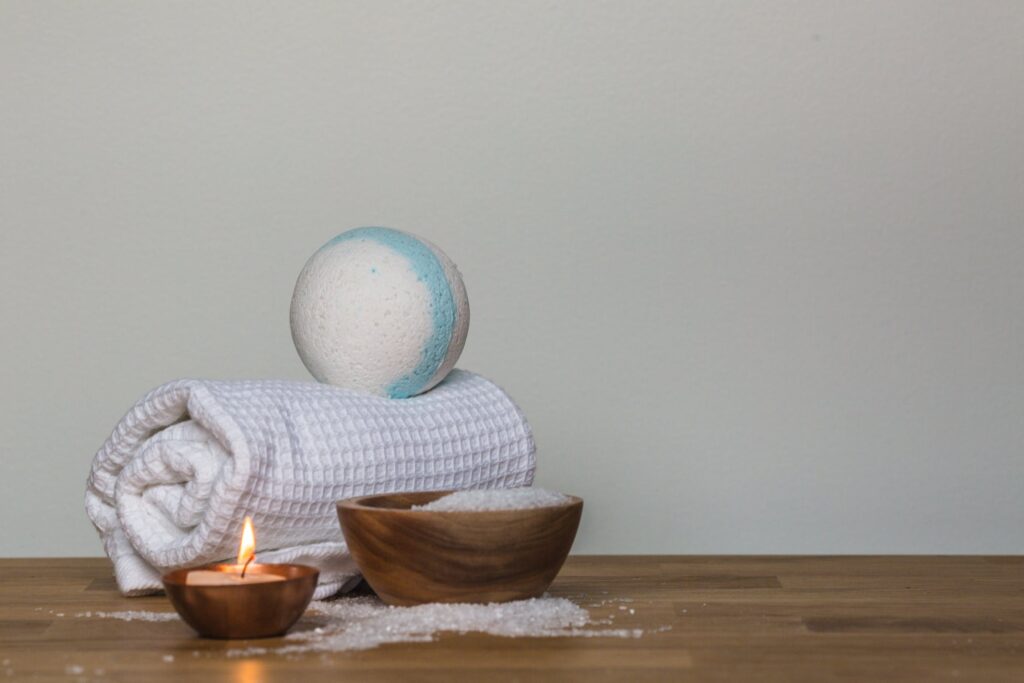You will realize that the sauna floor is the most refreshing aspect of the space. It is essential that you do not let this lead to any heat loss or poor insulation in any way. You will require a floor that can withstand high temperatures. There are several varieties of flooring options available to you that can fulfil this function for you. In addition to this, you need to ensure that the floor you select does not get excessively hot and cause pain to the soles of your feet.
If you want to build a sauna, you should think about utilizing a room that is on the smaller side. This will ensure that the heat is dispersed evenly throughout the space. If you have enough space in the room that you can both lie down and sit down comfortably on each bench, then the space is just right.
Steer clear of rooms with high ceilings because heat rises, making the lower bench cold and wasting energy on the heating system because the room must be filled to its capacity.
You should also be aware of how the entrance to the sauna is going to swing in order to prepare appropriately. It is important to leave enough space for the door to swing outward, away from the sauna. Trying to relax in a sauna while simultaneously avoiding getting hit in the elbow or the knee by an inward-swinging door is a losing battle. Have a look at the Portable Sauna Melbourne options we have available to find a solution to your problem.
Are you thinking of installing a sauna in your home, garden house, or backyard? There are many different kinds of saunas available, and there are a lot of them. Does this also apply particularly to sauna floors in the following ways: Wood? Tiles? PVC? Laminate? You will learn what needs a sauna must satisfy, as well as how the various sauna floors succeed in meeting those requirements, as we explain to you which Sauna Floors have what it takes to serve you well in the sauna.
Because the normal climate in a sauna can range from mild to hot and dry to steamy wet, the requirements for the materials that are used as Floors in a Sauna are extremely stringent. The weather is always subject to shifts and alterations: When in use, the sauna generates heat; when not in use, the temperature does not change. When it is in use, the humidity ranges from dry to steam-soaked, but when it is not in use, the humidity is dependent on the position of the sauna and, consequently, the surroundings.
However, the sauna is not the only thing that has an effect on the sauna. Hygiene, cleanliness and security, and safety are also criteria that are set for the Floors in the sauna. Similarly, the type of sauna or the type of heating technology that it employs might be deciding factors in selecting the best sauna.
FAQs About Sauna
Rinse off any sweat or dirt so you enter the sauna fresh, everyone in there with you will appreciate it. Stay aware of your space. Public saunas can get crowded, so be courteous and be wary of how much space you're taking up. If someone new joins the sauna, make room for them so everyone can sit comfortably. Be quick.
If you use a sauna regularly, your body will have help in removing excess water that causes bloating. When you then renew your hydration levels by drinking more water, your body can sweat even more in the sauna, moving more toxins, salt, and bloat out of you, giving you a slimmer appearance.
Whilst in the sauna, it's possible for you to achieve a passive cardiovascular workout. In effect, this is exercising by doing nothing. It doesn't take long either. You should feel the effects of a passive cardiovascular workout after 5 minutes of being in the sauna.
If you do happen to track dirt in your sauna, you can remove stains using a mild dish detergent mixed with warm water. To keep your sauna smelling fresh, mop the floors with a chemical-free, mild-detergent. Your sauna should not be operating or producing heat while you're cleaning.
You should take a hot shower or warm water and wash with soap before entering the sauna. This is not just a rule of hygiene but prepares the skin with open pores and relaxes the muscles throughout the body. Very important is to dry well before entering the sauna, otherwise it harder to sweat.
Concrete
The floor of a sauna should always be made of concrete because it is the most durable material. In order for it to be watertight, you will need to ensure that a sealer has been applied to it. After that, you can complete it by tiling it with ceramic. The tile can withstand the high temperatures in the sauna without making your feet feel uneasy when you walk on it. However, you will need to use extreme caution because tile can become extremely hazardous when wet. Before you walk on the tile, make sure the soles of your feet are fully dry and take slow, careful steps across the surface. Because of the potential for this sauna floor to be quite pricey, it is not always the first decision that people choose.
Vinyl
In the event that you have vinyl tiles in your sauna, you should know that they are able to handle both the heat and the humidity. However, even though they are initially more affordable, they do not last as long. Vinyl flooring will require more frequent replacement than ceramic tiles will.
Plywood
Make sure that the plywood floors you are functioning with are adequately sealed if you are going to be using them. You are going to want to use wood preservatives to seal all of the joints in the wood properly. Apply many coats of finish to ensure that the wood is well-protected. If you do not effectively defend the wood from the heat and humidity of the sauna, you may find that your plywood floors develop some problems.
Adhesives
In order to make the wooden floor in your sauna totally waterproof, you will need to utilize a variety of adhesives, each of which has its own specific purpose. Wood floors can be made watertight with the use of ceramic tiles, and seamless sheets of vinyl or fibreglass. However, you will still need to make use of the adhesives.
Know Your Flooring Material Options
Four characteristics must be present in the ideal flooring for use in showers, spas, saunas, and steam rooms. It must not have pores, be nonabsorbent, have a high resistance to slipping, and have a fast return to service time. It is to your advantage if the flooring is similarly appealing.
Stones such as slate, limestone, and marble have a captivating appeal. However, because they are made of porous materials, they need to have their seams resealed every several months when they are used in a climate that is both hot and humid. They also do not have the same level of resistance to slipping as other materials.
Wood or wood slates are frequently utilized in the construction of saunas, spas, and steam rooms; nevertheless, the porous and absorbent nature of wood goods makes them an ideal environment for the growth of mould and germs. If the wood is utilized in situations that are hot and humid, professionals from the industry recommend giving it a thorough hosing and cleaning once a week, including the lighting fixtures.
Tiles can be made to be nonporous and nonabsorbent throughout the manufacturing process, in addition to having the ability to resist slipping. The issue is the grout between the spaces. The grout shares none of the qualities of the tile and is a breeding ground for a wide variety of microorganisms, including bacteria and mould.
Concrete covered in polyurea emerges as the approach that best fits all four requirements, which are as follows:
- In environments such as saunas, spas, steam rooms, and wet rooms, it generates flooring that is impermeable and does not absorb moisture.
- It is possible to increase the coating's slide resistance by including anti-slip particles in the mixture.
- In addition, colour coatings and ornamental chips are offered so that the final product can meet the requirements of an aesthetically acceptable end product.
- It allows for a comeback to service in a matter of hours rather than days, as is the case with epoxy systems.
The Advantages of Polyurea Floor Coatings
Epoxy floor coatings have stronger chemical resistance and abrasion, but polyurea floor coatings offer an even higher resilience. This means that polyurea floor coatings will hold up better to frequent use and cleaning. It also has a higher resistance to yellowing when exposed to natural light; as a result, if your customer installs a window or skylight in the bath or spa, the flooring will not get cloudy over time.
Compared to epoxy floor coating, polyurea offers not only all of the benefits listed above but also the ability to form a considerably more robust and durable bond to concrete and the lowest levels of volatile organic compounds (VOCs).
In conclusion, polyurea floor coverings are more resistant to the temperature and humidity swings that are typical of saunas, spas, steam rooms, and other types of wet rooms.
Sauna: Which Floors are most popular?
In accordance with what was stated at the outset, the purpose of this section is to familiarize you with the traditional sauna floors, which have demonstrated their value in actual use.
Sauna Wood: The Classic
Wood is a natural and renewable material that, because of the usual colours of wood, creates a visually warm environment within the sauna. In addition to this, wood is excellent at taking in heat, storing it, and then radiating it back out again. Due to the poor heat conductivity of wood, even in a very hot sauna, the wood will not get too hot, making it an ideal material for the sauna in which you will be relaxing. In order to prevent your feet from getting too hot when walking on a wooden floor! In addition to this, there is a relatively low risk of falling when using wooden floors. Are you looking for the Melbourne Sauna? Stop looking, Portable Sauna has got you covered in every way.
However, the following Sauna Floors constructed of stone or ceramic are less likely to become dirty than wooden sauna floors. In any case, he is more concerned about the humidity than he is about that. As a result, the wood needs to be able to undergo enough drying after each operation in order to prevent long-term damage. Wood is, in general, a popular choice as a construction material for the construction of the inside cabin of saunas; however, you should only choose types of wood that do not resonate or splinter. In a nutshell, using wood for sauna floors is equally as beneficial as using it for sauna walls or ceilings.
As wood is not fireproof, our recommendation is that you should not place any wood on top of the sauna itself, as this is where the sauna is located. In addition, if any of the heated sauna's splinters fall off, they will create unsightly fire marks on the hardwood floor.
Sauna laminate
Laminate is also frequently used as a covering for wooden floors in saunas. However, there is a specialized type of laminate that is resistant to moisture and is designed to suit the criteria of saunas. To put it in the best possible light, it does not expand as rapidly as laminate and does not release any potentially dangerous vapours when heated.
Stone as Sauna Floors
Except for marble, a stone floor is unaffected by heat or moisture. The only exception to this is marble.
This not only becomes more susceptible to being dirty but also absorbs some water. In addition, the cost of washing the marble is high. Natural stone is an excellent choice for the construction of a sauna since not only is it incredibly durable, but it can also be shaped to prevent slipping. In terms of visual appeal, nature never fails to impress because it never fails to be distinctive. After all, no two stones are ever exactly alike. Stones can get very hot, so you should exercise caution around them.
Our suggestion is that although the stone may be described as having a chilly aspect at times, you may deliberately combat this impact by selecting stones with warmer tones.
Tiles as Sauna
Ceramic tiles are another time-honoured material; in fact, saunas in ancient Rome were lined with clay tiles that had been heated and coated. The durability and low maintenance of a tiled floor continue to make it a popular choice for flooring, even in modern homes. There have, for a long time, been tile options that offer high resistance to slipping. The substrate needs to be level in order to achieve the best possible results while installing the tiles. Important: Even though the tiles might get very hot, the floor of the sauna is always the coldest part of the room.
Tip: Tiled floors or even a fully tiled sauna can quickly give the impression of being cold and uninviting, particularly if the tiles are white. Therefore, go instead for ceramic tiles in warmer tones.
Sauna: Wood or tiles?
The answer to the question of whether you should buy wood or tiles for your sauna can only be determined on an individual basis by analyzing the benefits and drawbacks of both types of material and determining which aspects are most important to you.
You ought to be aware that the two types of material are frequently blended, namely: A The floors that are later covered with tiles or stone are given a so-called wood walking or walking surface, which can be readily removed in order to clean the tiles or stones that are underneath it.
Cork as Sauna Floors
Cork, much like wood, has a naturally developed structure that makes it an ideal material for use in saunas. It has a warm and non-slip surface, is soft to the touch (often even too soft), and does not slip.
A cork floor, which is similar to a wooden floor in that it does not appreciate excessive amounts of moisture, needs to have ample time to dry out after being in a sauna. Cork provides the same level of protection against fire that wood does, therefore, the two materials are interchangeable in this regard.
Coating as sauna floor covering
The use of a coating in the same capacity as a sauna is currently fashionable. In order to accomplish this goal, so-called epoxy glue is spread on the concrete floor of the sauna, where it is allowed to cure until it becomes hard and then is used to make the floors impermeable. A coated sauna is extremely smooth, sometimes to the point where it is uncomfortable to use.
Because of the coating's flawless surface, it requires a lot of care. You can give the coating a more rugged appearance by sprinkling in some individual flakes, which also make it look more appealing. Unfortunately, if the floors become wet in any way, they can be quite hazardous due to their slippery nature. You are also required to be aware that the layer of strong resin is equally fragile. If something were to fall on the coated sauna, there is a chance that a piece of it might break away. The worst-case scenario is that the resin layer is intact at the point of impact, but water still seeps through to the lower levels.
PVC as Sauna Floors
Another trend that extends beyond the confines of the sauna is the use of PVC flooring.
The availability on the market of a diverse selection of optics is the primary reason for the resurgence of interest in PVC flooring. These new optics make it possible to combine the positive properties of a material PVC, such as simple installation and maintenance, durability, and resistance to water and slipping, with more aesthetically pleasing stone or wood optics.
Stone carpet as Sauna Floors
To create a stone carpet, pebbles or other types of stones adhere to the floor of the sauna with an adhesive such as epoxy or polyurethane (PUR). The pebbly ground and the soothing, pleasant aspect are two characteristics that are typical of the area. Warmth is also imparted to the treading of the stone carpet by the air that is held in place by the coating. As a result of the pebbly surface's ability to absorb dust profoundly, not only is the dust less likely to be stirred up, but it is also much simpler to remove using an appropriate vacuum cleaner, provided that the dust is dry.
When it comes to thorough cleaning of a stone carpet, our recommendation is to use either a water vacuum cleaner or a steam cleaner. In the same vein, wet/dry vacuum cleaners are not advised because they leave behind an excessive amount of moisture in their wake.
Sauna Construction Details Often Overlooked
Throughout the years, we have discovered a great number of errors that were made during the construction of the sauna by novices. By presenting you with these simple guidelines for the highest possible level of security and convenience, we hope to spare you some trouble. Also, check out the Portable Sauna Melbourne page, which includes all the information regarding Portable Saunas that you could possibly require.
Clearances to Combustibles
The sauna heaters have minimal clearances from combustibles that must be maintained at all times. Always ensure that you adhere to the required clearances provided by the manufacturer. In order to appease your insurance provider, you might be required to have a WETT inspection for any wood-burning sauna heaters you have.
Sauna Door Swing
A sauna door always should swing out of the sauna so that it provides a speedy exit in the event that there is an emergency. This is for safety reasons. If rescue efforts are delayed, becoming trapped could end in your death.
In saunas where there is a lot of foot activity, the door should feature a window so that you don't accidentally run into someone who is behind you.
Air Circulation and Venting
If the appropriate safeguards are not taken into mind, a sauna that is both moist and heated might become a breeding ground for mould that is undesirable. After each use, the sauna needs to be rapidly ventilated and dried to reduce the risk of mould growth. It would be good to install a vent or window that can be opened after using the sauna in order to allow moisture to escape and to allow for the circulation of fresh air. If there is no other way to vent the room after using the sauna, leaving the door slightly ajar will be helpful.
Sizing
Most saunas are much larger than necessary, necessitating the use of more energy for heating. Take into account the number of individuals who would be using it simultaneously, and alter the size accordingly. Consider incorporating L-shaped or U-shaped benches into your design to minimize the amount of cubic area taken up by seating while maximizing the number of seats available. If the sauna has a wood-burning heater, you should also take into consideration the needed clearance between the benches and the heater.
Finishings
The wood will ultimately become discoloured from water and sweat, which will leave unsightly wear marks on seats and walls. Even if part of it can be sanded away to reveal the bare wood underneath, the deeper stains are much more difficult to remove. Sanding, on the other hand, is a filthy and laborious operation. The wood on the interior of the sauna should be protected, but not with a coating of paint, varnish, or lacquer. In high temperatures, these coatings may give off noxious fumes and cause the surfaces they are applied to become unbearably warm. The ideal solution is a natural sauna sealant that is water-based and dries without leaving any residue. It will prevent the wood from becoming stained or grey and will also seal the pores in the wood, which will keep your sauna looking as good as new.
Flooring
Inadequate drainage causes water to pool and allows moisture to stay, which can lead to problems with mould growth. For efficient and speedy removal of excess moisture, the floor of the sauna should be designed with a drain and a gentle slope that leads towards the drain. For ease of upkeep and protection, the floor covering ought to have a surface that is both water-resistant and simple to scrub. If they are not finished properly, cement floors can be uncomfortable for bare feet and can collect dirt easily. The tile is superior, yet it still feels cool underfoot, despite having grout lines that need to be cleaned. The epoxy paint method can be applied on top of a wooden subfloor and is the one that requires the least amount of effort to clean. Duckboards are a type of wooden slat mat that can be utilized anywhere that a person's feet come in contact with the floor to provide additional comfort. However, after leaving the sauna, they must be propped up on their edges and allowed to air dry.
The materials that are used in the creation of spas and saunas have to be able to withstand the specific environmental conditions that are present there, which include high levels of humidity constantly and temperature swings. Additionally, wet rooms are becoming increasingly popular, not just in private households but also in public establishments such as luxury gyms, hotels, and spas. A style of bathroom known as a "wet room" is one in which the shower, rather than being a distinct component, makes use of a floor that is flush with that of the bathroom's other components and is only divided from the rest of the space by a single wall or panel. These designs often consist of a drain situated close to the centre of the wet room, with the floors gradually sloping towards it to ease drainage. In addition, the walls of the wet room are typically tiled.
Conclusion
Sauna floors must be able to withstand high temperatures and not cause pain to the soles of the feet, and should be used in a room that is on the smaller side. The most important details are the requirements for Floors in a sauna, such as the type of sauna, type of heating technology, and hygiene, cleanliness, security, and safety. Wood preservatives, adhesives, ceramic tiles, and seamless sheets of vinyl or fibreglass can be used to make wood floors watertight, but four characteristics must be present in the ideal flooring for use in showers, spas, saunas, and steam rooms: nonporous, nonabsorbent, high resistance to slipping, and fast return to service time. Polyurea floor coatings offer higher chemical resistance and abrasion, higher resilience to frequent use and cleaning, and a higher resistance to yellowing when exposed to natural light. Wood is a popular choice for sauna floors, but it is not fireproof and should not be placed on top of the sauna itself.
Stone is an excellent choice for the construction of a sauna, as it is durable and can be shaped to prevent slipping. Ceramic tiles are a popular choice for saunas due to their durability and low maintenance, while cork is an ideal choice due to its warm and non-slip surface, soft to the touch, and ability to dry out after use. PVC as Sauna Floors is becoming increasingly popular due to its easy installation and maintenance, durability, and resistance to water and slipping, as well as its ability to absorb dust. The most important details are clearances to combustibles, air circulation and venting, door swing, size, finishings, and ventilation. The ideal solution is a natural sauna sealant that is water-based and dries without leaving any residue. Wet rooms are becoming increasingly popular due to high levels of humidity and temperature swings, with epoxy paint and duckboards used to provide comfort.
Content Summary
- You will realize that the sauna floor is the most refreshing aspect of the space.
- You will require a floor that can withstand high temperatures.
- If you want to build a sauna, you should think about utilizing a room that is on the smaller side.
- You should also be aware of how the entrance to the sauna is going to swing in order to prepare appropriately.
- It is important to leave enough space for the door to swing outward, away from the sauna.
- You will learn what needs a sauna must satisfy, as well as how the various sauna floors succeed in meeting those requirements, as we explain to you which Sauna Floors have what it takes to serve you well in the sauna.
- Because the normal climate in a sauna can range from mild to hot and dry to steamy wet, the requirements for the materials that are used as Floors in a Sauna are extremely stringent.
- Hygiene, cleanliness and security, and safety are also criteria that are set for the Floors in the sauna.
- Similarly, the type of sauna or the type of heating technology that it employs might be deciding factors in selecting the best sauna.
- VinylIn the event that you have vinyl tiles in your sauna, you should know that they are able to handle both the heat and the humidity.
- Vinyl flooring will require more frequent replacement than ceramic tiles will.
- Make sure that the plywood floors you are functioning with are adequately sealed if you are going to be using them.
- If you do not effectively defend the wood from the heat and humidity of the sauna, you may find that your plywood floors develop some problems.
- However, you will still need to make use of the adhesives.
- However, the following Sauna Floors constructed of stone or ceramic are less likely to become dirty than wooden sauna floors.
- As wood is not fireproof, our recommendation is that you should not place any wood on top of the sauna itself, as this is where the sauna is located.
- Stone as Sauna FloorsExcept for marble, a stone floor is unaffected by heat or moisture.
- Important: Even though the tiles might get very hot, the floor of the sauna is always the coldest part of the room.
- Therefore, go instead for ceramic tiles in warmer tones.
- Sauna: Wood or tiles?The answer to the question of whether you should buy wood or tiles for your sauna can only be determined on an individual basis by analyzing the benefits and drawbacks of both types of material and determining which aspects are most important to you.
- Another trend that extends beyond the confines of the sauna is the use of PVC flooring.
- To create a stone carpet, pebbles or other types of stones adhere to the floor of the sauna with an adhesive such as epoxy or polyurethane (PUR).
- Warmth is also imparted to the treading of the stone carpet by the air that is held in place by the coating.
- When it comes to thorough cleaning of a stone carpet, our recommendation is to use either a water vacuum cleaner or a steam cleaner.
- Throughout the years, we have discovered a great number of errors that were made during the construction of the sauna by novices.
- Also, check out the Portable Sauna Melbourne page, which includes all the information regarding Portable Saunas that you could possibly require.
- Always ensure that you adhere to the required clearances provided by the manufacturer.
- Sauna Door SwingA sauna door always should swing out of the sauna so that it provides a speedy exit in the event that there is an emergency.
- This is for safety reasons.
- It would be good to install a vent or window that can be opened after using the sauna in order to allow moisture to escape and to allow for the circulation of fresh air.
- If the sauna has a wood-burning heater, you should also take into consideration the needed clearance between the benches and the heater.
- The wood on the interior of the sauna should be protected, but not with a coating of paint, varnish, or lacquer.
- It will prevent the wood from becoming stained or grey and will also seal the pores in the wood, which will keep your sauna looking as good as new.
- For efficient and speedy removal of excess moisture, the floor of the sauna should be designed with a drain and a gentle slope that leads towards the drain.
- For ease of upkeep and protection, the floor covering ought to have a surface that is both water-resistant and simple to scrub.
- The epoxy paint method can be applied on top of a wooden subfloor and is the one that requires the least amount of effort to clean.
- Duckboards are a type of wooden slat mat that can be utilized anywhere that a person's feet come in contact with the floor to provide additional comfort.
- However, after leaving the sauna, they must be propped up on their edges and allowed to air dry.
- A style of bathroom known as a "wet room" is one in which the shower, rather than being a distinct component, makes use of a floor that is flush with that of the bathroom's other components and is only divided from the rest of the space by a single wall or panel.
- In addition, the walls of the wet room are typically tiled.


